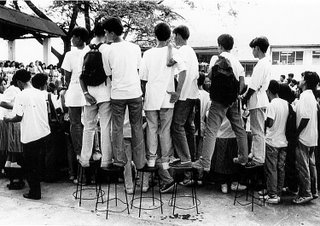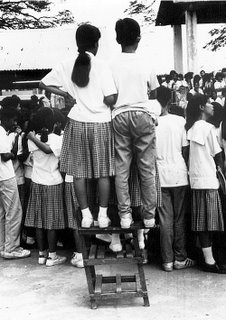| Update as of September 18, 2023:
If you’re a high school or grade school student in the Philippines who’s joining the photojournalism contest in the division, regional, or national press conference, I’m offering two free resources to you : A. 900-plus interactive exercises on English grammar, vocabulary, reading comprehension, verbal analogy, etc (with around 200 megabytes total file size). The exercises have time limit and automatic scoring, with an average of 10 items per exercise. Examples of these interactive exercises are: Common English grammar errors: Exercise 01 (nouns - confusions of number); Phrasal Verbs: Expressions with Go; English Placement Test (45 items). B. 200-plus resources (JPG, PDF, MP4, etc.) on photography and photojournalism, with 600-plus megabytes total file size. For some examples of these resources, surf to the “Free photography e-books, cheat sheets” page. For the download links and more information about how to use the interactive exercises, please surf to my “Better English resources and exercises” blog. Please inform your journalism teacher/schoolpaper adviser or your parents about these resources before downloading them. If you have any question about downloading or using these free resources, please email me (after informing your journalism teacher/schoolpaper adviser or your parents). I’ll be able to reply to you within two to three days; if you don’t see my reply in your Inbox, check your Spam folder. Or, you can text me. Also, if you win in the photojournalism contest at whatever level (district, division, regional, or national), you can send me your prizewinning pictures, and I will feature them in a blog post. Atty. Gerry T. Galacio gtgalacio@yahoo.com 0927-798-3138 |
| Examples of photo essays: Trouble Shared (Brenda Ann Kennelly/ New York Times/Lens); A Country Doctor (W. Eugene Smith/Magnum for Life); A Young Father’s Balancing Act (Benjamin Norman/The New York Times); New York City Coffeehouse (Dima Gavrysh/Lens); Where Beauty Softens Your Grief (Gianni Cipriano/ICP); Gun Nation (Zed Nelson); What the World Eats (Time); Last Supper (2004; Celia A. Shapiro/Mother Jones); The Bitter Sweet Pill – GMB Akash; Happy Horsemeat (Alex Soth) Unusual photo essays: February Assignment: Photographing Pictures in Reflection; Magic in the Nearly Forgotten Mailbox; Andrew Moore Detroit; Dulce Pinzon (The real story of the Superheroes; A Photo Fright Most Viral; Jump Book – Phillippe Halsman |
Limiting the topic for your photo essay
We’re all familiar with writing essays or themes for our English or Filipino subjects. What do teachers emphasize before you write out that essay? Limit your topic. The same advice holds true for a photo essay:
1. Decide first what your general topic or your subject will be - people, places, events, programs, universal truths, etc.
2. After deciding on your general topic, the next step is to come up with a limited topic. People- concentrate on one person or a specific group; places - your school, your community; activities - enrollment, graduation, summer class; universal truths - love between a mother and child, pizza’s the best thing ever to happen in history...
Using themes for your photo essay
A photo essay can make use of certain themes. Various pictures taken in different places, different times of the day, can be grouped together to illustrate a certain theme, whether serious or lighthearted, significant or trivial, like the pictures below which show students using chairs in creative ways other than sitting on them.


 Speaking of themes ... if you have seen the Oscar best picture for l989, “The Last Emperor” directed by Bernardo Bertolucci, then you probably know that the recurring thematic device used all through the movie was the opening and closing of all kinds of doors or entrances.
Speaking of themes ... if you have seen the Oscar best picture for l989, “The Last Emperor” directed by Bernardo Bertolucci, then you probably know that the recurring thematic device used all through the movie was the opening and closing of all kinds of doors or entrances.| Relevant article: “Week Five_The Photo Essay” from CUNY Graduate School of Journalism (topics include kinds of shots like signature shot, process, interaction, clincher, etc., and how to structure your narrative) |
In whatever way you develop your photo essay, thematically or chronologically (we’ll discuss this next time), you have to vary your shots, your viewpoints. Use close-ups, medium shots, full shots and long shots. You have to employ a variety of lenses. You have to shoot at different times of the day; use different viewpoints (eye level, low and high). You also have to shoot using both horizontal and vertical formats.
Kinds of pictures in a photo essay
In a written essay, you have the introduction, the body, and the ending or conclusion. In a photo essay, you would need different kinds of pictures - (1) establishing shots to show your viewers the setting or context of your subject; (2) major actions, stages or developments, to illustrate your theme or subject: (3) minor pictures which can serve as transitions; and, (4) pictures that will effectively close out your photo essay.
In a written essay, you always try to end it with a punch, with a line or expression that gives it a sense of completeness, a sense that nothing has been left hanging. With a photo essay, you try to end it with a picture that also brings a sense of completeness. In literature, we call this sense of completeness as “catharsis” which means a purgation of the negative emotions created within the reader. In Hollywood film making and scriptwriting, it’s called “closure” which means that the ending must provide a sense of completeness, a sense that everything has been resolved satisfactorily.
National Geographic Live! - Alison Wright: Portraits of the Human Spirit: After confronting her own mortality in a near-fatal bus crash, photographer Alison Wright dedicates her career to capturing the human spirit through her photographs and writing.

Hello po,
ReplyDeleteSi Grace Madriñan po ito, not sure if you will still remember me. I used to be the most quiet student of yours, batch 1992. Anyway, just want to say hello. Looking at these pictures makes me think of high school again, the ups and downs. And I miss photography too..Anyway, my e-mail address is grace.madrinan@intel.com just in case if you want to get in touch or may reunion.
regards,
Grace
i m call kevin janvier i attend photo workshop and right now i want to become a photojournalist ,please contact me on jankevin_rose@yahoo.com I really like photojournalism
ReplyDelete